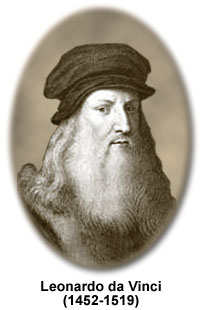Leonardo da Vinci
(1452-1519)

Leonardo da Vinci was a painter, sculptor, architect, engineer, scientist and genius who best represents the ideals of the Renaissance period. He was one of the greatest painters of all times. The Last Supper and the Mona Lisa are two of his best known paintings.
Da Vinci was born in Vinci, Italy in 1452. His early education was at home where he studied reading, writing and arithmetic. When he was 20 years old he became an apprentice in the studio of Andrea Verrocchio learning painting, sculpture and acquiring technical and mechanical skills. His highly inventive style and technical skills were quickly recognized, and he eventually began to work for himself in Florence as a painter and also sketching pumps, military weapons, and other machines. Da Vinci was a great engineer and inventor who designed buildings, bridges, canals, forts and war machines. He was also fascinated by birds and flying and drew designs of fantastic flying machines. Da Vinci kept huge notebooks of his fantastic designs, sketches and ideas.
In his notebooks, da Vinci wrote using "mirror writing", writing backwards from right to left. In order to read this type of writing, you must place a mirror beside it and read the reversed image in the mirror. No one knows why Leonardo wrote this way, but some believe he was trying to avoid theft of his ideas. Others point out that he was left-handed, which made it easier for him to write from right to left.
In 1482, da Vinci began to work for the Duke of Milan as a painter and engineer. In this capacity he not only painted, but designed buildings and hydraulic and mechanical systems. It was during this time that da Vinci developed a fascination with geometry. He particularly enjoyed finding mechanical solutions to geometric problems.
Da Vinci was also intrigued with the study of optics and conducted extensive investigations and made drawings about the nature of light, reflections, and shadows. Even though it was not until over 100 years later that the first telescope was invented by Hans Lippershey, da Vinci realized the possibility of using lenses and mirrors to view heavenly bodies. In his notebooks he writes of:
...making glasses to see the Moon enlarged... and ...in order to observe the nature of the planets, open the roof and bring the image of a single planet onto the base of a concave mirror. The image of the planet reflected by the base will show the surface of the planet much magnified.
In 1499, the French armies defeated the Duke of Milan and da Vinci returned to Florence to become the chief architect and engineer for the ruling Borgia family. He worked on plans to divert the River Arno and to build a canal to give Florence access to the sea. During this period, engineering and scientific work was given precedence over his painting. He was involved in studying and working in hydraulics, anatomy, mechanics, mathematics and optics.
The reputation of da Vinci's genius became known throughout Europe. In 1516, he was invited to France by the King to become his head painter, architect and mechanic. Da Vinci was allowed to work on any project he wished. He spent much of this time, writing, arranging and editing his studies. He did not paint much but finished his paintings of Saint John the Baptist, Mona Lisa, and the Virgin and Child with Saint Anne. Da Vinci died in 1519 and was buried in the Church of Saint Valentine at Amboise, France.
